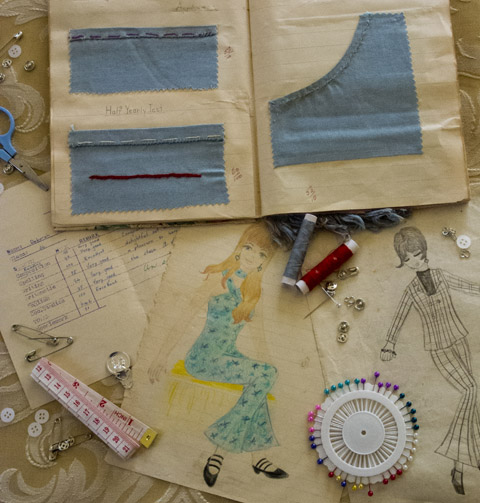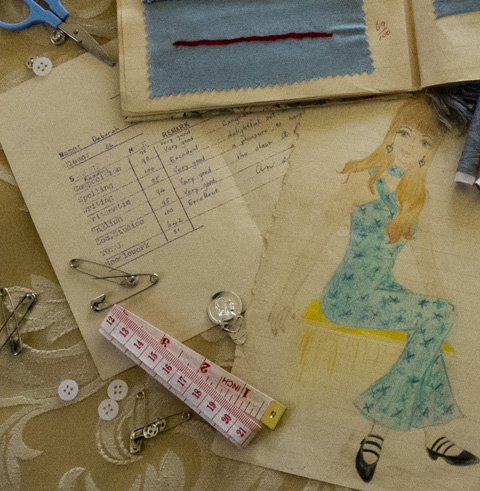![]() Recreational Sewing in Cesarine
Recreational Sewing in Cesarine

Recently, while I was browsing through some boxes of memorabilia, I came across my old primary school report cards. They date back to an era when the subjects (now known as learning areas) were: Reading, Composition, Spelling, Writing, Arithmetic, English (i.e. grammar), Social Studies and something with the odd name of ‘Recreational Sewing’.
Suddenly all the memories flooded back. Sewing had been the curse of my primary school days, followed very closely by arithmetic. I had tried a couple of ploys to get out of needlework. The first was to offer to spend the sewing lesson doing extra maths. To my childish way of thinking, that seemed like a very reasonable exchange. The school, however, didn’t agree. According to my class teacher, the curriculum required that I undertake two hours of ‘handcrafts’ a week and there was no room for negotiation.
So I convinced my mum to write a note asking if I could do basket-weaving instead of needlework. (You see, in that long-ago pre-feminist era, girls did sewing lessons and boys made waste-paper baskets.) But that ploy failed too when the headmaster sternly reminded me that girls needed to learn how to sew. ‘It’s a foundation for your future life as a housewife,’ he said. After his pronouncement, there was no further court of appeal. Ahead of me lay four years of compulsory sewing. Four years of torture involving needle and thread.
Back in the present day, I continued to trawl through the boxes of memorabilia, only to find the document which held the record of my inglorious needlework career from ages seven to eleven – my sewing exercise book. It was still intact and neatly covered in wrapping paper decorated with flower fairies.
So what did I find inside? Well, the book begins promisingly enough with a pretty title page. (Title pages and lettering were my specialty.) ‘Excellent work’, the sewing teacher had written at the bottom of the page, accompanied by a penguin stamp. It was the last ‘excellent’ I was ever to receive in needlework lessons.
The next few pages are set out in columns headed ‘Article’, ‘Material’, ‘Start’, ‘Finish’ and ‘Marks’. In the ‘material’ column, the word ‘cesarine’ appears again and again. Cesarine? It sounds very Sixties and synthetic, doesn’t it? I Googled the word and discovered it was the ‘wonder cloth’ of the post-war years developed by a Sydney company called Caesar Fabrics. And it wasn’t synthetic at all but a kind of thick cotton which didn’t wrinkle and was popular for uniforms.
Using the aforementioned cesarine, I had made (in chronological order): a pin wheel, a needle case and a bag for my cotton thread. The bag must have been a mammoth task because I'd started it in September and didn’t complete it until December. The finished product received a mark of 5 ½ out of ten! Oh dear! No trace of it remains, nor of the other items.
In the subsequent years it appears that I made the following: a desk cover (whatever that was) an apron, a petticoat and panties, a huckaback guest towel, a throw over, a tray cloth and the piece-de-resistance of Grade 6, a ‘frock’. At the end of the year there was a fashion parade in which we modelled our ensembles in front of our parents. I don’t think I ever wore that ‘frock’ again – I hated it so much!
Now back to the sewing book. Each of the subsequent pages features samples of different stitches and techniques sewn on rectangles of the ubiquitous cesarine, the edges trimmed with pinking shears. The samples are covered in rusty marks which are most certainly ancient blood stains - the result of accidents with a needle or even a stray pin. How peculiar that my DNA is forever embedded in that cesarine.
Here are some of the tasks we were required to master: running stitch, top sewing, tacking a hem, chain stitch, rosebuds (rusty smudges everywhere), a French hem, sewing on of tape, a run and fell seam, shell hemming, blanket stitch , herring bone variations, backstitching, a continuous placket, buttonhole stitch, bias binding and darning a thin place (yes, that was the exact heading).
I seemed to be the only girl in the class whose cotton thread formed itself into a Gordian knot at least once every lesson, requiring me to go up to the sewing teacher’s desk and beg her to untangle it. ‘Deborah, how could you possibly get your thread in such a mess?’ she would ask in an exasperated tone. Which brings me to the teacher herself. One of the scariest people I’ve ever met. She never smiled. Well, at least, not at me. I can see her dour face even now.
Did I ever overcome my dislike of sewing and transform myself into an embroiderer or a quilter? I’m ashamed to confess that I didn’t. Instead, I did deals with my talented friends. I would paint a portrait of their child and in return they would make me a quilt, cross-stitch a sampler or embroider a cushion. My house is filled with exquisite needlework – none of it made by me!
And there’s an ironic twist to this story. As a teenager, I dreamed of becoming a fashion designer. You can see some of my youthful efforts on this page. I could draw the outfits on paper, but there was no way that I could ever make them. Sewing was anathema to me. That’s why my fashion design career ended before it began !
Deborah O’Brien
October, 2012
